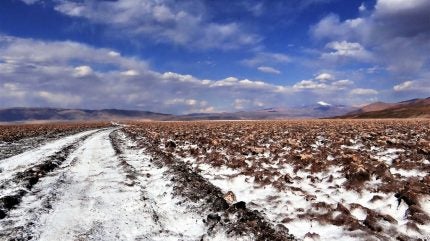
The recent announcement that Rio Tinto has partnered with space exploration company Fleet Space Technologies to map Argentina’s Rincon lithium project in 3D using artificial intelligence (AI) demonstrates the continued integration of the technology into mining operations – and the step change in innovation it can offer the industry.
The 3D maps outputted through the use of AI will detail the subsurface of the reservoir, basement depth and brine influencing structures across 100 square kilometres of the project’s salt flat and nearby subvolcanic structures. Of their significance, Flavia Tata Nardini, co-founder and CEO of Fleet Space Technologies, said: “We look forward to bringing the latest innovations in spacetech, 3D multiphysics and AI to unlock new insights, predictive capabilities and sustainability benefits to advance the development of world-class operations globally.”
The Fleet Space Technologies tie-up is the latest of numerous cutting-edge applications of AI being explored by Rio Tinto. But the mining giant has already integrated the technology across its operations in many ways that are simply aimed at improving existing processes, as Dan Evans, Rio Tinto’s CIO, explained to Mining Technology.
How is Rio Tinto currently using AI?
Dan Evans: At Rio Tinto, we have leveraged valuable AI solutions across the mining value chain, including mine planning, processing and safety, stockpiling, logistics and marketing. Our goal in leveraging AI is to achieve operational excellence by enhancing safety, improving efficiency and reducing costs, all in line with our objective of being the “Best Operator”.
Beyond operational improvements, AI also plays a pivotal role in supporting our environmental, social and governance (ESG) commitments. Our team, over the past two years, has implemented impactful use cases to improve the monitoring of threatened species near Rio Tinto operations.

This includes using AI for conservation of Palm Cockatoos at Weipa. We have developed an open-source object-detection model called YOLOv5, which stands for ‘you only look once’, to identify palm cockatoos and similar species in images. This model can quickly process thousands of images, categorise them and simplify the verification process.
How well do you really know your competitors?
Access the most comprehensive Company Profiles on the market, powered by GlobalData. Save hours of research. Gain competitive edge.

Thank you!
Your download email will arrive shortly
Not ready to buy yet? Download a free sample
We are confident about the unique quality of our Company Profiles. However, we want you to make the most beneficial decision for your business, so we offer a free sample that you can download by submitting the below form
By GlobalDataUsing this solution, we have successfully identified 35,000 palm cockatoos from more than 2.6 million images. This has significantly enhanced both the speed and accuracy of identification compared to traditional manual methods.
These AI-driven conservation efforts not only protect biodiversity but also underscore our commitment to impeccable ESG practices.
What types of AI is Rio Tinto employing and in what parts of operations?
We use various AI and machine learning (ML) technologies across our operations to enhance efficiency, safety and innovation. These include predictive asset health, smart mine planning and health, safety and environment (HSE) initiatives.
Depending on the complexity of business requirements, we apply different levels of AI/ML technology, including descriptive, diagnostic, predictive and prescriptive analytics, to build our AI solutions. Recently, we have extensively applied cutting-edge technologies, such as generative AI and computer vision, to streamline and automate our operations.
For instance, we have developed a knowledge-based chatbot similar to GPT that extracts key insights from hundreds of documents at various levels. This tool supports various use cases in our business, from research and development to annual planning, citing and highlighting relevant content from the source documents.
What advantages does AI offer to the mining sector?
AI offers substantial benefits to the mining industry, driving optimisation, safety, efficiency and innovation while minimising the environmental impact:
- Optimisation: AI technologies, such as predictive asset health and smart mine planning, help optimise the entire mining process by considering the constraints and bottlenecks throughout the value chain.
- Safety: AI plays a crucial role in improving safety within mining operations. The enhanced predictive asset health system can monitor and analyse processes in real time, identifying potential hazards and preventing accidents.
- Efficiency: AI-driven solutions boost the efficiency of mining operations by automating repetitive tasks and optimising workflows. Recently, generative AI and computer vision technologies have been largely used to improve operational efficiency by reducing manual effort.
- Environmental impact: AI helps organisations reduce their carbon footprint, support communities worldwide and enable sustainable operations while reducing costs.
- Innovation: AI fosters innovation by enabling the development of new technologies and solutions. For instance, we have been leveraging generative AI to summarise the key findings of literature reviews in geoscience.
What challenges are there to navigate when integrating AI into mining operations?
Integrating AI into mining operations presents several challenges that need to be navigated carefully to ensure successful implementation and maximum benefits:
- Data management: Mining operations generate vast amounts of data from various sources, making it challenging to manage and analyse. AI can streamline data integration and processing, but consolidating fragmented and siloed data across different systems and sources remains a significant concern.
- Skill gaps: There is often a shortage of skilled professionals who can develop, implement and maintain AI solutions. Upskilling employees and attracting new talent with the necessary expertise is crucial.
- Technology integration: Integrating AI with existing technologies and systems can be complex. Ensuring compatibility and seamless operation between AI tools in the internal ecosystem requires complex planning and execution.
- Cost and investment: Implementing AI solutions can be costly, requiring significant investment in technology, infrastructure and training. Balancing these costs with the expected benefits is a critical consideration.
- Change management: Introducing AI into mining operations often requires a cultural shift within the organisation. Effective change management strategies are essential to address these issues and ensure smooth user adoption and engagement.
- Regulatory and ethical considerations: Mining companies must navigate regulatory requirements and ethical considerations when implementing AI. Ensuring compliance with data privacy laws and addressing ethical concerns related to AI decision-making are important aspects of AI integration.
- Scalability: Scaling AI solutions across multiple sites and operations is both time consuming and challenging. Each mine site has unique characteristics and requirements, making it difficult to implement a ‘one-size-fits-all’ solution.
What are Rio Tinto’s plans for AI and ML over the next decade?
The AI landscape is changing rapidly and will continue to evolve over the next decade. Data and analytics, including AI and ML, are vital for gaining competitive advantage and providing sustained value throughout the organisation in the next decade. While Rio Tinto has been using these techniques for several years such as in equipment automation and predictive asset health – there is a pressing need to consistently integrate these technologies into our operational decision-making and across our value chains.
For instance, our Mine Automation System consolidates data from 98% of our sites to provide operational insights using advanced algorithms. Information can be visualised via RTVis – Rio Tinto Visualisation – or traditional dashboards used to drive in-shift decision making.
It enables interoperability among diverse autonomous equipment and utilises AI for tasks like orebody modelling, equipment dispatch optimisation and blast control. We have optimised the speed and reduced queuing for our autonomous trucks, leading to significant productivity gains from these small improvements.
Our opportunity lies in establishing a data AI ecosystem that enables our teams to access the right data and seamlessly integrate it with advanced AI and ML techniques in a scalable, low-friction manner. The right mix of technology and governance will enhance our data and AI capabilities, enabling our decision-makers to make informed local decisions while considering the impact on our overall performance.
We will continue to use these techniques to address complex challenges in exploration, mining digital twins, energy management, mineral extraction and metals processing.
How will AI affect the mining industry and Rio Tinto’s place in it?
We are making substantial investments in a range of technologies and infrastructure to harness AI insights effectively:
- Skilled workforce: We continue to invest in upskilling our workforce and attracting new talent with expertise in AI, data science, ML and related fields. This ensures that we have the necessary skills to develop, implement and maintain AI solutions.
- Internet of Things (IoT) sensors: We have invested in IoT sensors to collect real-time data from equipment and operations. These sensors also monitor key performance indicators and relay information to AI systems, enabling predictive asset health and optimising the mining process.
- Data platform: To manage the vast amounts of data generated by our mining operations, we have invested in advanced data management systems. These systems facilitate the integration, processing, storage and analysis of data from various sources, making it possible to derive valuable insights.
- AI/ML infrastructure: Building and maintaining the infrastructure necessary for AI and ML, including high-performance computing systems and cloud-based platforms, is essential. These investments support the development, deployment and scaling of AI solutions across the organisation.
How will the integration of AI into mining affect Rio Tinto’s hiring patterns?
The integration of AI into mining will drive a shift in hiring patterns towards more specialised, tech-savvy professionals who can support our strategy and vision, digital transformation and net-zero emission goal. As AI technologies become more embedded in mining processes, there will be an increased demand for professionals with expertise in AI, ML, data science and related fields.
Also, we are focusing on upskilling our existing workforce to ensure that employees have the necessary skills to work with AI technologies. This may involve training programmes and workshops to help employees adapt to new tools and processes.
What is the progress of AI integration across Rio Tinto’s network of mines?
We are actively working on integrating AI technologies across our network of mines to enhance operational efficiency, safety and sustainability.
The level of AI integration can differ from one site to another. This disparity is often due to factors such as the complexity of mining operations, the availability of data infrastructure and the readiness of the workforce to embrace digital transformation.
We are committed to advancing our AI capabilities and ensuring that all our sites benefit from these technologies. We are making substantial progress in integrating AI across our operations and continue to invest in AI-driven solutions and talent to maintain our competitive edge.
Our Pilbara operations are the most advanced in terms of supply chain integration of AI and automation technologies, given the scale of opportunities achievable across the vast network.




